Influence of an Organic Fertilizer on Agronomic Characteristics and Herbaceous Plant Diversity in a Greek Ecosystem: The Case of Cretan Dittany (Origanum dictamnus L.)
Abstract
1. Introduction
2. Materials and Methods
2.1. Site Description
2.2. Meteorological Data
2.3. Soil and Plant Analysis
2.4. Establishment of Field Experiment and Measurements
2.5. Herbaceous Plant Composition
2.6. Statistical Analysis
3. Results
3.1. Effect of Fertilization in Plant Height
3.2. Effect of Fertilization on Fresh and Dry Weight
3.3. Effect of Fertilization in Leaf Area Index (LAI)
3.4. Herbaceous Plant Composition and Diversity
4. Discussion
4.1. Effect of Organic Fertilization in Plant Height, Fresh and Dry Weight, and in LAI
4.2. Herbaceous Plant Composition, Species Richness and Diversity
5. Conclusions
Author Contributions
Funding
Institutional Review Board Statement
Data Availability Statement
Acknowledgments
Conflicts of Interest
References
- Dimopoulos, P.; Raus, T.; Bergmeier, E.; Constantinidis, T.; Iatrou, G.; Kokkini, S.; Strid, A.; Tzanoudakis, D. Vascular plants of Greece: An annotated checklist. Supplement. Willdenowia 2016, 46, 301–347. [Google Scholar] [CrossRef]
- Menteli, V.; Krigas, N.; Avramakis, M.; Turland, N.; Vokou, D. Endemic plants of Crete in electronic trade and wildlife tourism: Current patterns and implications for conservation. J. Biol. Res. Thessalon. 2019, 26, 10. [Google Scholar] [CrossRef]
- Gotsiou, P.; Naxakis, G.; Skoula, M. Diversity in the composition of monoterpenoids of Origanum microphyllum (Labiatae). Biochem. Syst. Ecol. 2002, 30, 865–879. [Google Scholar] [CrossRef]
- Ietswaart, J.H. A Taxonomic Revision of the Genus Origanum (Labiatae); Leiden Botanical Series; Springer: Dordrecht, The Netherlands, 1980; Volume 4, pp. 1–153. [Google Scholar]
- Karousou, R.; Kokkini, S. The genus Origanum (Labiatae) in Crete: Distribution and essential oils. Bocconea 2003, 16, 717–721. [Google Scholar]
- Martini, A.N.; Papafotiou, M.; Massas, I.; Chorianopoulou, N. Growing of the Cretan Therapeutic Herb Origanum Dictamnus in The Urban Fabric: The Effect of Substrate and Cultivation Site on Plant Growth and Potential Toxic Element Accumulation. Plants 2023, 12, 336. [Google Scholar] [CrossRef]
- Liolios, C.C.; Graikou, K.; Skaltsa, E.; Chinou, I. Dittany of Crete: A botanical and ethnopharmacological review. J. Ethnopharmacol. 2010, 131, 229–241. [Google Scholar] [CrossRef]
- Krigas, N.; Lazari, D.; Maloupa, E.; Stikoudi, M. Introducing Dittany of Crete (Origanum dictamnus L.) to gastronomy: A new culinary concept for a traditionally used medicinal plant. Int. J. Gastron. Food Sci. 2015, 2, 112–118. [Google Scholar] [CrossRef]
- Varsani, M.; Graikou, K.; Velegraki, A.; Chinou, I. Phytochemical Analysis and Antimicrobial Activity of Origanum dictamnus Traditional Herbal Tea (decoction). Nat. Prod. Commun. 2017, 12, 1934578X1701201139. [Google Scholar] [CrossRef]
- Kouri, G.; Tsimogiannis, D.; Bardouki, H.; Oreopoulou, V. Extraction and analysis of antioxidant components from Origanum dictamnus. Innov. Food Sci. Emerg. Technol. 2007, 8, 155–162. [Google Scholar] [CrossRef]
- Chinou, I.; Liolios, C.; Moreau, D.; Roussakis, C. Cytotoxic activity of Origanum dictamnus. Fitoterapia 2007, 78, 342–344. [Google Scholar] [CrossRef]
- Maleš, I.; Pedisić, S.; Zorić, Z.; Elez-Garofulić, I.; Repajić, M.; You, L.; Vladimir-Knežević, S.; Butorac, D.; Dragović-Uzelac, V. The medicinal and aromatic plants as ingredients in functional beverage production. J. Funct. Foods 2022, 96, 105210. [Google Scholar] [CrossRef]
- Badalingappanavar, R.; Hanumanthappa, M.; Veeranna, H.; Kolakar, S.; Khidrapure, G. Organic fertilizer management in cultivation of medicinal and aromatic crops: A review. J. Pharmacogn. Phytochem. 2018, 7, 126–129. [Google Scholar]
- Bilias, F.; Ipsilantis, I.; Samara, E.; Tsoktouridis, G.; Glavakis, E.; Grigoriadou, K.; Krigas, N.; Matsi, T. From the wild to the field: Effect of foliar or soil application of inorganic or semi-organic fertilizers on various parameters of four local endemic plant species of Crete (Greece). Braz. J. Bot. 2023, 46, 319–336. [Google Scholar] [CrossRef]
- Itelima, J.; Bang, W.; Onyimba, I.; Sila, M.; Egbere, O. Bio-fertilizers as key player in enhancing soil fertility and crop productivity: A review. Direct Res. J. Agric. Food Sci. 2018, 6, 73–83. [Google Scholar]
- Gholami, S.; Pishva, Z.K.; Talaei, G.H.; Amini, M. Effects of biological and chemical fertilizers nitrogen on yield and yield components in cumin (Cuminum cyminum L.). Int. J. Biosci. (IJB) 2014, 4, 93–99. [Google Scholar]
- Mącik, M.; Gryta, A.; Sas-Paszt, L.; Frąc, M. The Status of Soil Microbiome as Affected by the Application of Phosphorus Biofertilizer: Fertilizer Enriched with Beneficial Bacterial Strains. Int. J. Mol. Sci. 2020, 21, 8003. [Google Scholar] [CrossRef]
- Giller, K.E.; Delaune, T.; Silva, J.V.; Descheemaeker, K.; van de Ven, G.; Schut, A.G.T.; van Wijk, M.; Hammond, J.; Hochman, Z.; Taulya, G.; et al. The future of farming: Who will produce our food? Food Secur. 2021, 13, 1073–1099. [Google Scholar] [CrossRef]
- Springmann, M.; Clark, M.; Mason-D’Croz, D.; Wiebe, K.; Bodirsky, B.L.; Lassaletta, L.; De Vries, W.; Vermeulen, S.J.; Herrero, M.; Carlson, K.M. Options for keeping the food system within environmental limits. Nature 2018, 562, 519–525. [Google Scholar] [CrossRef]
- Aryal, J.P.; Sapkota, T.B.; Krupnik, T.J.; Rahut, D.B.; Jat, M.L.; Stirling, C.M. Factors affecting farmers’ use of organic and inorganic fertilizers in South Asia. Environ. Sci. Pollut. Res. 2021, 28, 51480–51496. [Google Scholar] [CrossRef]
- Molla, A.; Skoufogianni, E.; Lolas, A.; Skordas, K. The Impact of Different Cultivation Practices on Surface Runoff, Soil and Nutrient Losses in a Rotational System of Legume–Cereal and Sunflower. Plants. 2022, 11, 3513. [Google Scholar] [CrossRef]
- Rahman, K.M.A.; Zhang, D. Effects of Fertilizer Broadcasting on the Excessive Use of Inorganic Fertilizers and Environmental Sustainability. Sustainability 2018, 10, 759. [Google Scholar] [CrossRef]
- Quemada, M.; Lassaletta, L.; Jensen, L.; Godinot, O.; Brentrup, F.; Buckley, C.; Foray, S.; Hvid, S.; Oenema, J.; Richards, K. Exploring nitrogen indicators of farm performance among farm types across several European case studies. Agric. Syst. 2020, 177, 102689. [Google Scholar] [CrossRef]
- Montemurro, F.; Persiani, A.; Diacono, M. Organic Vegetable Crops Managed with Agro-Ecological Practices: Environmental Sustainability Assessment by DEXi-met Decision Support System. Appl. Sci. 2019, 9, 4148. [Google Scholar] [CrossRef]
- Diacono, M.; Baldivieso-Freitas, P.; Sans Serra, F.X. Nitrogen Utilization in a Cereal-Legume Rotation Managed with Sustainable Agricultural Practices. Agronomy 2019, 9, 113. [Google Scholar] [CrossRef]
- Van Wyk, A.; Prinsloo, G. Medicinal plant harvesting, sustainability and cultivation in South Africa. Biol. Conserv. 2018, 227, 335–342. [Google Scholar] [CrossRef]
- Chen, S.-L.; Yu, H.; Luo, H.-M.; Wu, Q.; Li, C.-F.; Steinmetz, A. Conservation and sustainable use of medicinal plants: Problems, progress, and prospects. Chin. Med. 2016, 11, 37. [Google Scholar] [CrossRef] [PubMed]
- Yan, W.; Zhu, Y.; Zhang, S.; Wang, Y. What could promote farmers to replace chemical fertilizers with organic fertilizers? J. Clean. Prod. 2018, 199, 882–890. [Google Scholar] [CrossRef]
- Shahini, S.; Kachanova, T.; Manushkina, T.; Petrova, O.; Shevchuk, N. Using organic nitrogen fertilisers to improve soil health and increase yields. Int. J. Environ. Stud. 2023, 80, 433–441. [Google Scholar] [CrossRef]
- Hammad, H.M.; Khaliq, A.; Abbas, F.; Farhad, W.; Fahad, S.; Aslam, M.; Shah, G.M.; Nasim, W.; Mubeen, M.; Bakhat, H.F. Comparative Effects of Organic and Inorganic Fertilizers on Soil Organic Carbon and Wheat Productivity under Arid Region. Commun. Soil Sci. Plant Anal. 2020, 51, 1406–1422. [Google Scholar] [CrossRef]
- Zhou, Z.; Zhang, S.; Jiang, N.; Xiu, W.; Zhao, J.; Yang, D. Effects of organic fertilizer incorporation practices on crops yield, soil quality, and soil fauna feeding activity in the wheat-maize rotation system. Front. Environ. Sci. 2022, 10, 1058071. [Google Scholar] [CrossRef]
- Sharafzadeh, S.; Ordookhani, K. Organic and bio fertilizers as a good substitute for inorganic fertilizers in medicinal plants farming. Aust. J. Basic Appl. Sci. 2011, 5, 1330–1333. [Google Scholar]
- Naguib, N.Y.M. Organic vs chemical fertilization of medicinal plants: A concise review of researches. Adv. Environ. Biol. 2011, 5, 394–400. [Google Scholar]
- Singh, M.; Guleria, N. Influence of harvesting stage and inorganic and organic fertilizers on yield and oil composition of rosemary (Rosmarinus officinalis L.) in a semi-arid tropical climate. Ind. Crops Prod. 2013, 42, 37–40. [Google Scholar] [CrossRef]
- Ibrahim, M.H.; Jaafar, H.Z.E.; Karimi, E.; Ghasemzadeh, A. Impact of Organic and Inorganic Fertilizers Application on the Phytochemical and Antioxidant Activity of Kacip Fatimah (Labisia pumila Benth). Molecules 2013, 18, 10973–10988. [Google Scholar] [CrossRef] [PubMed]
- Bouyoucos, G.J. Hydrometer Method Improved for Making Particle Size Analyses of Soils1. Agron. J. 1962, 54, 464–465. [Google Scholar] [CrossRef]
- Walkley, A.; Black, I.A. An examination of the degtjareff method for determining soil organic matter, and a proposed modification of the chromic acid titration method. Soil Sci. 1934, 37, 29–38. [Google Scholar] [CrossRef]
- Bremner, J.; Sparks, D. Methods of Soil Analysis. Part 3. Chemical Methods; Soil Science Society of America: Madison, WI, USA, 1996; pp. 1103–1108. [Google Scholar]
- Kuo, S. SSSA Book Series; Sparks, D.L., Page, A.L., Helmke, P.A., Loeppert, R.H., Soltanpour, P.N., Tabatabai, M.A., Johnston, C.T., Sumner, M.E., Eds.; Soil Science Society of America, American Society of Agronomy: Madison, WI, USA, 1996; pp. 869–919. [Google Scholar]
- Thomas, G.W. Exchangeable cations. In Methods of Soil Analysis: Part 2 Chemical and Microbiological Properties; Soil Science Society of America: Madison, WI, USA, 1983; Volume 9, pp. 159–165. [Google Scholar]
- Cook, C.W.; Stubbendieck, J. Range Research: Basic Problems and Techniques; Society for Range Management: Denver, CO, USA, 1986. [Google Scholar]
- Seaby, R.; Henderson, P. Species Diversity and Richness Version 4; Pisces Conservation Ltd.: Lymington, UK, 2006; Volume 123. [Google Scholar]
- Heuserr, M. Putting Diversity Indices into Practice: –Some Considerations for Forest Management in The Netherlands. Assessment of Biodiversity for Improved Planning; Springer: New York, NY, USA, 1998; pp. 171–180. [Google Scholar]
- Kent, M. Vegetation Description and Data Analysis: A Practical Approach; John Wiley & Sons: Hoboken, NJ, USA, 2011. [Google Scholar]
- Whittaker, R.H. Evolution and measurement of species diversity. Taxon 1972, 21, 213–251. [Google Scholar] [CrossRef]
- Dimopoulos, P.; Raus, T.; Bergmeier, E.; Constantinidis, T.; Iatrou, G.; Kokkini, S.; Strid, A.; Tzanoudakis, D. Vascular Plants of Greece: An Annotated Checklist; Botanic Garden and Botanical Museum Berlin-Dahlem: Berlin, Germany; Hellenic Botanical Society: Athens, Greece, 2013; Volume 31, p. 372. [Google Scholar]
- Paschalidis, K.; Fanourakis, D.; Tsaniklidis, G.; Tzanakakis, V.A.; Bilias, F.; Samara, E.; Kalogiannakis, K.; Debouba, F.J.; Ipsilantis, I.; Tsoktouridis, G.; et al. Pilot Cultivation of the Vulnerable Cretan Endemic Verbascum arcturus L. (Scrophulariaceae): Effect of Fertilization on Growth and Quality Features. Sustainability 2021, 13, 14030. [Google Scholar] [CrossRef]
- Sarkar, S.; Singh, S.R.; Singh, R.P. The effect of organic and inorganic fertilizers on soil physical condition and the productivity of a rice–lentil cropping sequence in India. J. Agric. Sci. 2003, 140, 419–425. [Google Scholar] [CrossRef]
- Afrad, M.S.I.; Rahman, G.K.M.M.; Alam, M.; Ali, M.Z.; Barau, A.A. Effects of Organic and Inorganic Fertilizers on Growth and Yield of Different Crops at Charlands in Bangladesh. Asian J. Adv. Agric. Res. 2021, 17, 27–40. [Google Scholar] [CrossRef]
- Fang, H.; Baret, F.; Plummer, S.; Schaepman-Strub, G. An Overview of Global Leaf Area Index (LAI): Methods, Products, Validation, and Applications. Rev. Geophys. 2019, 57, 739–799. [Google Scholar] [CrossRef]
- Parker, G.G. Tamm review: Leaf Area Index (LAI) is both a determinant and a consequence of important processes in vegetation canopies. For. Ecol. Manag. 2020, 477, 118496. [Google Scholar] [CrossRef]
- Molla, A.; Solomou, A.; Tziouvalekas, M.; Lolas, A.; Skoufogianni, E. Dynamics of Agronomic Characteristics and Plant Diversity in Lemon Verbena (Aloysia citrodora Paláu) Cultivation in Greece. Agriculture 2024, 14, 97. [Google Scholar] [CrossRef]
- Skoufogianni, E.; Molla, A.; Angelaki, A.; Golia, E.E. Effect of Bio-nitrogen Fertilization, Plant Density and Irrigation on Physiological and Agronomic Characteristics of Salvia officinalis Organic Cultivation. Univers. J. Agric. Res. 2022, 10, 804–813. [Google Scholar] [CrossRef]
- Slamet, W.; Purbajanti, E.D.; Darmawati, A.; Fuskhah, E. Leaf area index, chlorophyll, photosynthesis rate of lettuce (Lactuca sativa L.) under N-organic fertilizer. Indian J. Agric. Res. 2017, 51, 365–369. [Google Scholar] [CrossRef][Green Version]
- Prabhu, M.; Kumar, A.R.; Rajamani, K. Influence of different organic substances on growth and herb yield of sacred basil (Ocimum sanctum L.). Indian J. Agric. Res. 2010, 44, 48–52. [Google Scholar]
- Halpern, C.B.; Lutz, J.A. Canopy closure exerts weak controls on understory dynamics: A 30-year study of overstory–understory interactions. Ecol. Monogr. 2013, 83, 221–237. [Google Scholar] [CrossRef]
- Tichý, L.; Axmanová, I.; Dengler, J.; Guarino, R.; Jansen, F.; Midolo, G.; Nobis, M.P.; Van Meerbeek, K.; Aćić, S.; Attorre, F.; et al. Ellenberg-type indicator values for European vascular plant species. J. Veg. Sci. 2023, 34, e13168. [Google Scholar] [CrossRef]
- Zolotova, E.; Ivanova, N.; Ivanova, S. Global Overview of Modern Research Based on Ellenberg Indicator Values. Diversity 2023, 15, 14. [Google Scholar] [CrossRef]
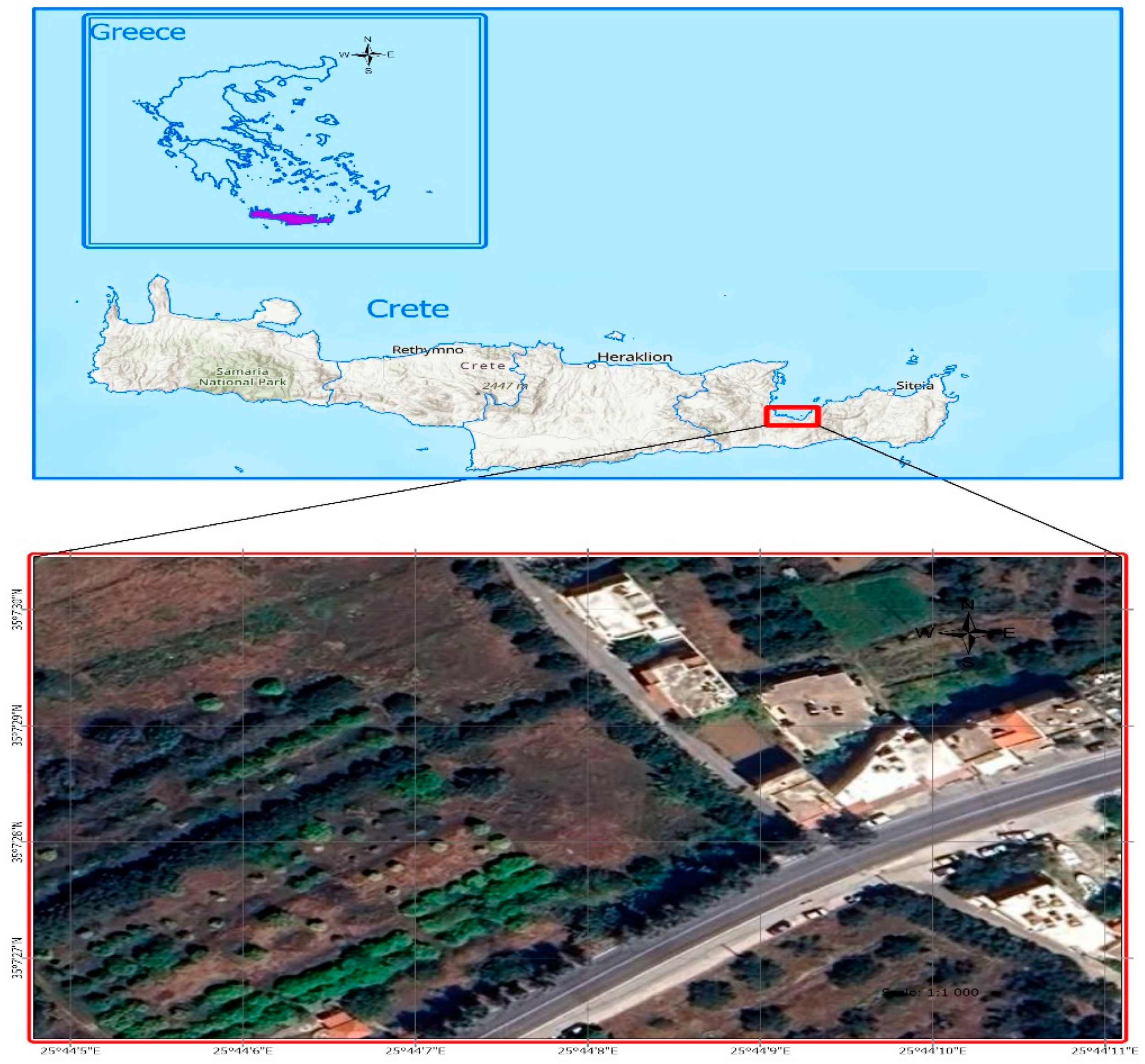
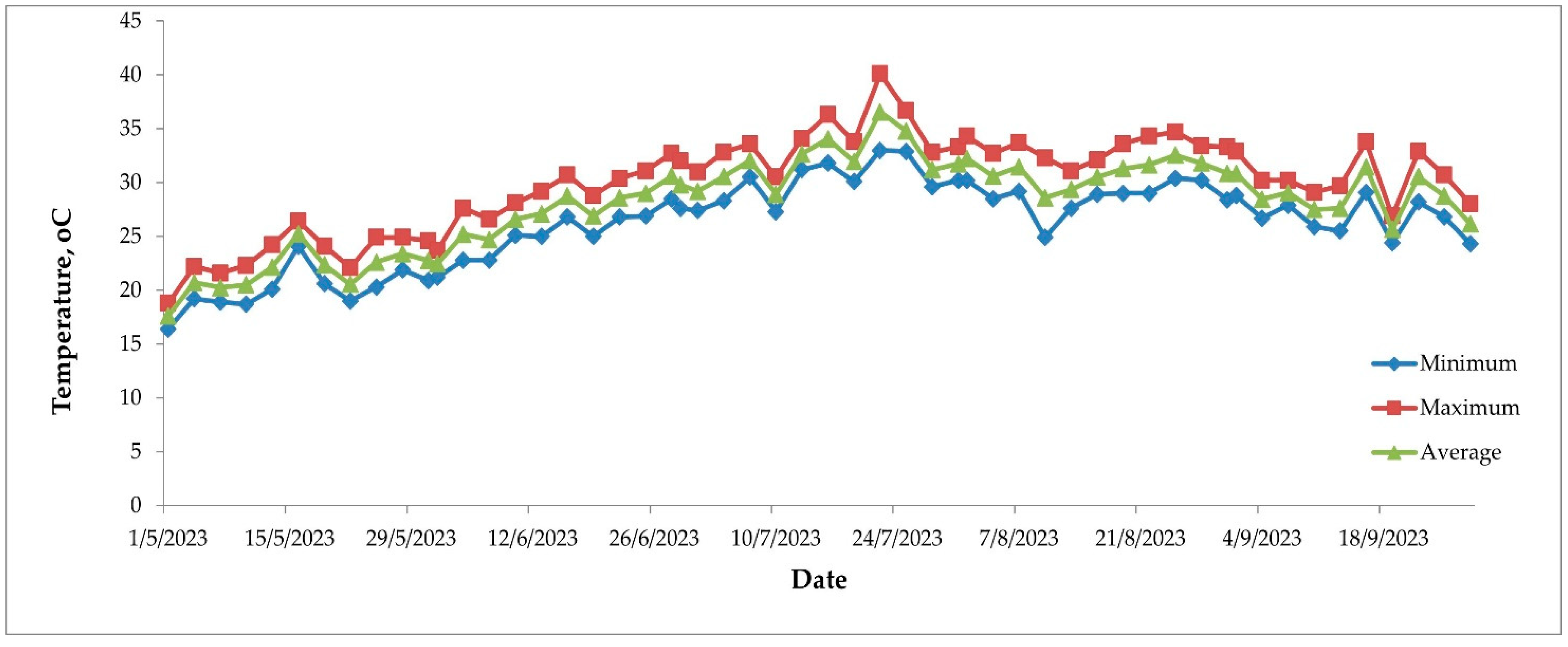
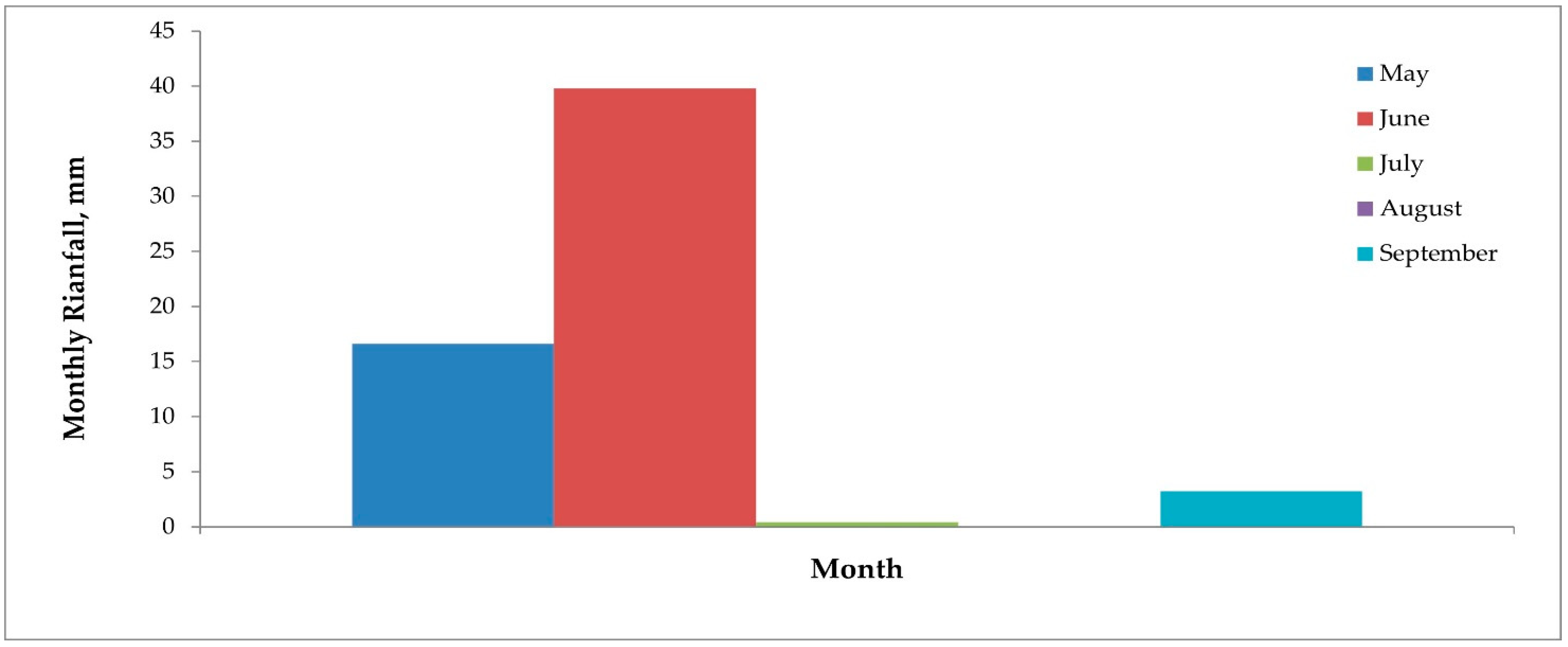
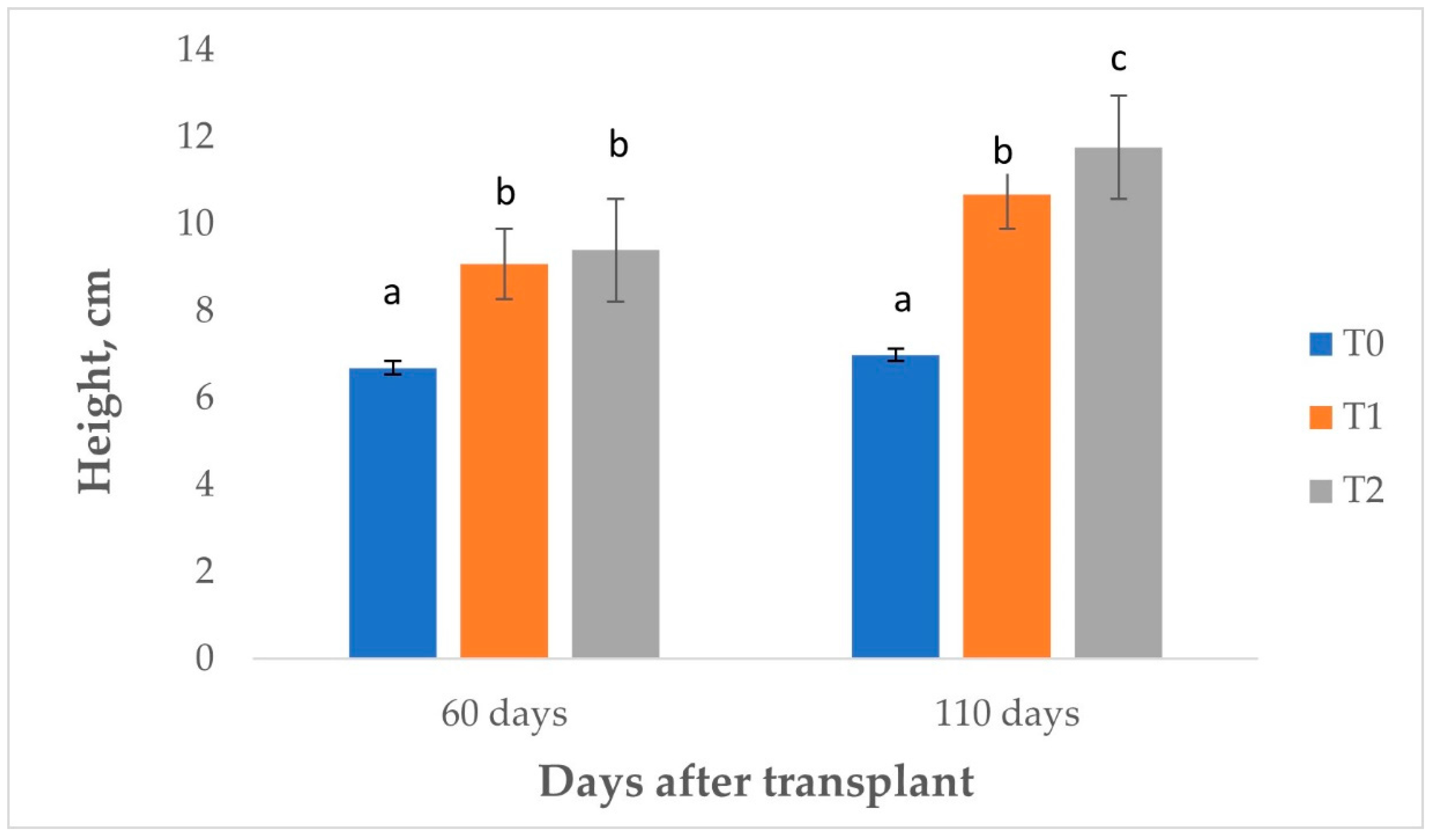
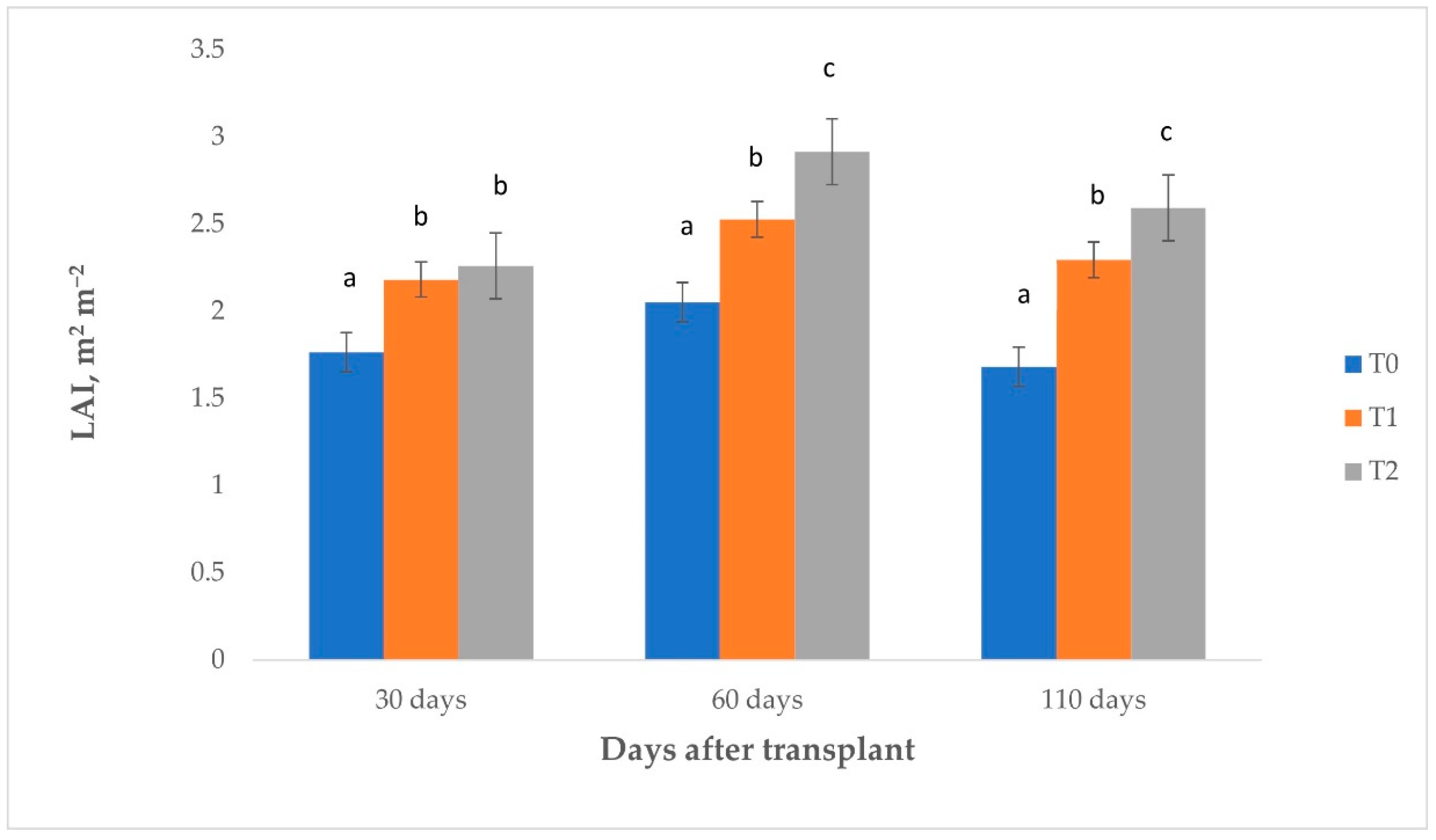

| 0.30 cm | |
|---|---|
| pH | 7.31 |
| E.C. (mS cm−1) | 1.04 |
| CaCO3 | 3.98 |
| Organic matter (%) | 2.25 |
| Total nitrogen (%) | 0.08 |
| Olsen P (mg kg−1) | 20.08 |
| Exchangeable Κ (mg kg−1) | 162.63 |
| Sand (%) | 68.90 |
| Clay (%) | 12.20 |
| Silt (%) | 18.90 |
| Treatments | Fresh Weight (g/Plant) | |
|---|---|---|
| Days after Transplant | ||
| 60 Days | 110 Days | |
| T0 | 56.0 a | 55.6 a |
| T1 | 99.3 b | 98.9 b |
| T2 | 120.8 c | 119.6 c |
| LSD | 0.9451 | 1.0613 |
| Treatments | Dry Weight (g/Plant) | |
|---|---|---|
| Days after Transplant | ||
| 60 Days | 110 Days | |
| T0 | 18.5 a | 18.2 a |
| T1 | 32.9 b | 32.2 b |
| T2 | 39.1 b | 38.5 c |
| LSD | 0.3643 | 0.3678 |
| Herbaceous Plant Species | Family | Relative Abundance |
|---|---|---|
| Aegilops geniculata Roth | Poaceae | 5.26 |
| Amaranthus graecizans L. | Amaranthaceae | 1.75 |
| Anagallis arvensis L. | Primulaceae | 3.51 |
| Anthemis arvensis L. | Asteraceae | 21.05 |
| Avena sterilis L. | Poaceae | 5.26 |
| Capsella bursa-pastoris (L.) Medik. | Brassicaceae | 7.02 |
| Convolvulus arvensis L. | Convolvulaceae | 3.51 |
| Daucus carota L. | Apiaceae | 7.02 |
| Hordeum murinum L. | Poaceae | 1.75 |
| Lolium rigidum Gaudin | Poaceae | 1.75 |
| Oxalis pes-caprae L. | Oxalidaceae | 1.75 |
| Papaver rhoeas L. | Papaveraceae | 1.75 |
| Piptatherum miliaceum (L.) Coss. | Poaceae | 17.54 |
| Setaria viridis (L.) P. Beauv. | Poaceae | 1.75 |
| Silybum marianum (L.) Gaertn. | Asteraceae | 3.51 |
| Sinapis arvensis L. | Brassicaceae | 3.51 |
| Sorghum halepense (L.) Pers. | Poaceae | 5.26 |
| Urtica pilulifera L. | Urticaceae | 7.02 |
| Total: 18 | Total: 10 | Total: 100 |
| Treatments | Number of Herbaceous Plant Species |
|---|---|
| T0 | 9 |
| T1 | 14 |
| T2 | 18 |
| Treatments | Shannon Diversity Index |
|---|---|
| T0 | 1.83 |
| T1 | 2.14 |
| T2 | 2.41 |
Disclaimer/Publisher’s Note: The statements, opinions and data contained in all publications are solely those of the individual author(s) and contributor(s) and not of MDPI and/or the editor(s). MDPI and/or the editor(s) disclaim responsibility for any injury to people or property resulting from any ideas, methods, instructions or products referred to in the content. |
© 2024 by the authors. Licensee MDPI, Basel, Switzerland. This article is an open access article distributed under the terms and conditions of the Creative Commons Attribution (CC BY) license (https://creativecommons.org/licenses/by/4.0/).
Share and Cite
Molla, A.; Solomou, A.D.; Fountouli, A.; Chatzikirou, E.; Stamatakis, E.; Stamatakis, P.; Skoufogianni, E. Influence of an Organic Fertilizer on Agronomic Characteristics and Herbaceous Plant Diversity in a Greek Ecosystem: The Case of Cretan Dittany (Origanum dictamnus L.). Nitrogen 2024, 5, 426-438. https://doi.org/10.3390/nitrogen5020027
Molla A, Solomou AD, Fountouli A, Chatzikirou E, Stamatakis E, Stamatakis P, Skoufogianni E. Influence of an Organic Fertilizer on Agronomic Characteristics and Herbaceous Plant Diversity in a Greek Ecosystem: The Case of Cretan Dittany (Origanum dictamnus L.). Nitrogen. 2024; 5(2):426-438. https://doi.org/10.3390/nitrogen5020027
Chicago/Turabian StyleMolla, Aikaterini, Alexandra D. Solomou, Anastasia Fountouli, Evaggelia Chatzikirou, Emmanouil Stamatakis, Petros Stamatakis, and Elpiniki Skoufogianni. 2024. "Influence of an Organic Fertilizer on Agronomic Characteristics and Herbaceous Plant Diversity in a Greek Ecosystem: The Case of Cretan Dittany (Origanum dictamnus L.)" Nitrogen 5, no. 2: 426-438. https://doi.org/10.3390/nitrogen5020027
APA StyleMolla, A., Solomou, A. D., Fountouli, A., Chatzikirou, E., Stamatakis, E., Stamatakis, P., & Skoufogianni, E. (2024). Influence of an Organic Fertilizer on Agronomic Characteristics and Herbaceous Plant Diversity in a Greek Ecosystem: The Case of Cretan Dittany (Origanum dictamnus L.). Nitrogen, 5(2), 426-438. https://doi.org/10.3390/nitrogen5020027









